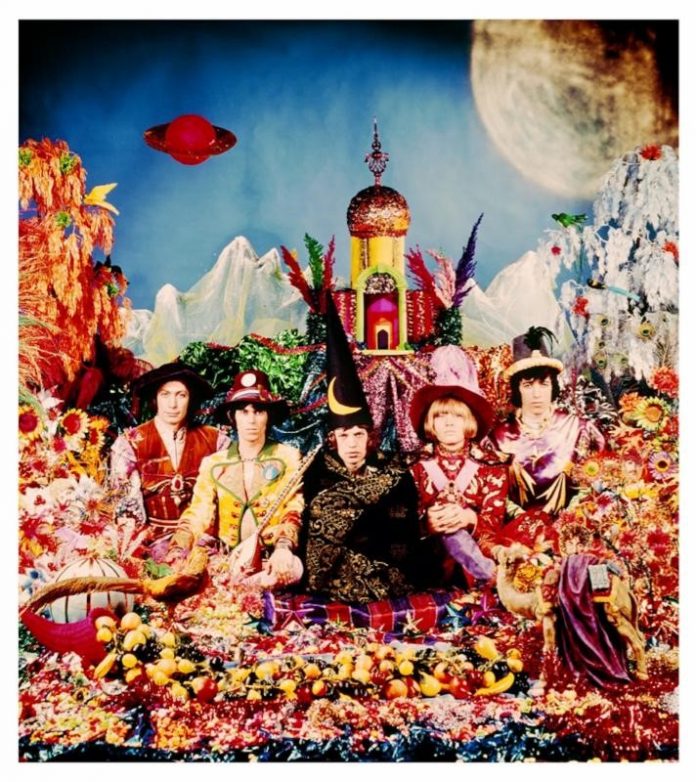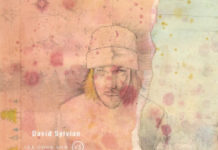In 1967, inspired by the eclectic psychedelia of The Beatles’ Sgt. Pepper’s Lonely Hearts Club Band, The Rolling Stones got to work on a similarly trippy musical journey. The result was Their Satanic Majesties Request, an album that initially drew mixed reviews but has become a well-respected part of the Stones’ work in the decades since.
If the cover for that album bears a striking resemblance to the Sgt. Pepper cover, it’s no mistake: The Stones were so impressed with the photos for The Beatles’ album that they asked Sgt. Pepper photographer Michael Cooper to create a similar effect for their release.
It was natural that The Stones would tap Cooper for the cover of their foray into psychedelia. Cooper’s vision was a fantastical 3-dimensional image – one that was only possible with a camera located at Mount Vernon Studios in New York City. The Stones were able to book studio time on September 13 and 14, 1967, but with the caveat that they had to take care of everything from the props to the clothing.
On the 50th anniversary of the release of Their Satanic Majesties, Morrison Hotel Gallery is excited to host Their Satanic Majesties Request: The Making of an Album Cover, a celebration of the album, Cooper’s photographic storytelling, and all of the work that went into bringing it to life.
Their Satanic Majesties Request: The Making of an Album Cover tells the story of that session through a selection of 20 images. Of the outtakes, over a dozen images have never been seen by the general public. Morrison Hotel Gallery is proud to be able to celebrate this historic album in the same city where its iconic imagery came into being. The exhibit will also honor the artistry behind the album cover that was to become one of Cooper’s most recognized works. Opening on September 7th, the show will be up until September 20th at Morrison Hotel Gallery’s SoHo location.
The shoot for Sgt. Pepper and Satanic Majesties couldn’t have been more different. While The Beatles had the red carpet rolled out for them, simply arriving for their shoot, being photographed, and leaving, The Stones had to sweat. Under Cooper’s direction, the band shopped for everything, sewed, glued, prepared all of the clothes, flowers, and everything appearing on the cover. After an exhaustive amount of prep work, the scene was ready. The result was a legendary cover for an album that marked The Rolling Stones’ first foray into psychedelia and sound effects.
Known as “the poet of the lens” by his friend Christopher Gibbs, Cooper wasn’t always a rock photographer. Instead, he started his career at Vogue magazine. After some time, he sought freedom and broke out on his own, traveling and photographing the world with his Nikon F.
In 1964, he met renowned London art dealer Robert Fraser, who introduced him to musical icons such as The Beatles, The Rolling Stones, Marianne Faithfull, and others. As he built his career as a photographer, he became close friends with the legends on whom he turned his lens. Faithfull described Cooper as, “the man who floated around the scene with a single lens – reflex eye, invisible, but ever present.”
Of Cooper, John Lennon said, “Of all the photographers, Michael was without a doubt the best documentarian of this magnificent decade. He truly understood our dreams for the future and what the 60´s really meant.”
Michael Cooper always appeared to be there when it mattered, an alchemical presence, and his closest friend Keith Richards said, “Satanic Majesties! Michael got you up to some amazing things, I mean, here we´re making our own set for the album cover… ‘Got the glue?’ or ‘Can I have that saw when you´ve finished with it?’ Handicrafts for two or three days, he kept popping out and buying things when we ran out. Bits of Styrofoam and God knows what. Millions of bits of sequins, rhinestones, and beads!”
Once he worked with The Beatles on the cover for Sgt. Pepper, Cooper had secured a permanent place among the greats of musical photography.







